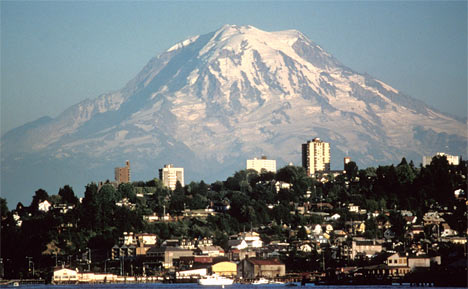The Highest Threat Volcanoes in the United States
In the years since the cataclysmic eruption of Mount St. Helens, scientific and technological advances in volcanology have enabled new models of volcanic risks and assessment.
One such assessment and monitoring model proposed by the USGS, the ‘National Volcano Early Warning System’, contains a very interesting list.
It is a categorization and risk assessment of volcanoes in the United States, including these which are classified as the highest threat of them all…
The NVEWS is an assessment of the United States volcanoes and their monitoring needs based on the threats posed by the 169 volcanoes which are geologically active within the nation.
Roughly half of the Nation’s 169 young volcanoes are dangerous because of the manner in which they erupt and the communities within their reach.
Volcanoes produce many kinds of destructive phenomena and operate on individual time scales, some progressing to eruption very quickly (days to weeks), others needing months to a year or more.
While we most often hear of volcanoes and eruptions in other parts of the world, there are potentially dangerous volcanoes within the United States.
The USGS NVEWS list was created by analyzing and weighing many factors of each individual volcano. Some of these eruptive hazards and factors include…
Volcano type
Occurrence of unrest
Frequency of past eruptions
Tendency toward explosivity
Airborne-ash hazard to aviation
Carbon-dioxide degassing from soils and lakes
Far-reaching lateral blasts
Scope of volcanic mudflows
People and property risk
Exposure factors
Power generation/transmission hazards
Most Dangerous Volcanoes in the U.S.
Washington
Glacier Peak
Mount Adams
Mount Baker
Mount Rainier
Mount St. Helens
Oregon
Crater Lake
Mount Hood
Newberry
Three Sisters
California
Clear Lake
Lassen Volcanic Center
Medicine Lake
Mono-Inyo Craters
Mono Lake Volcanic Field
Mount Shasta
Wyoming
Yellowstone
Hawaii
Hualalai
Kilauea
Mauna Loa
Alaska
Akutan
Amak
Amukta
Augustine
Black Peak
Bogoslof
Chiginagak
Churchill
Cleveland
Dana
Douglas
Dutton
Edgecumbe
Fourpeaked
Hayes
Kaguyak
Kasatochi
Kiska
Kupreanof
Makushin
Recheshnoi
Redoubt
Seguam
Spurr
Vsevidof
Wrangell
Yantarni
Yunaska
Do you live near any of these volcanoes? Even if you don’t, you could be affected by an eruption. It’s always good to know the threats around you…


You could actually include the whole Long Valley Caldera rather than just Momo-Inyo and Momo Lake. Long Valley is under close U.S.G.S. scrutiny.
The series of novels “Deep Winter”, “Shatter”, and “Remnant” tell a good tale of what could happen following an eruption of Mt. Rainier. Thomas Sherry is the author.
Past Yellowstone eruptions have been calculated to be at 2.1 million years ago, the next one 800 thousand years later at 1.3 million years ago, the next one 660 thousand years later at 640 thousand years ago. The shortest interval between those raw numbers is the 660 thousand year gap between the last 2 eruptions.
But if you look at the decreasing interval between eruptions, the next eruption should have happened already, at approx. 550 thousand years after the last one, or 90 thousand years ago.
So are we way-overdue for a big one?
That’s an interesting way to look at it. Logical. One never knows I suppose until the earthquake swarms and uplift suddenly get under way. Hopefully not in my lifetime though ;)
Stand my Ground, Yes, it was a terrible frightening day when Mt St Helens exploded. It was just happenstance that my parents bought the house when they did many years earlier. Have been doing some research. If there’s time later today I’ll write up what I’ve found and put it here.